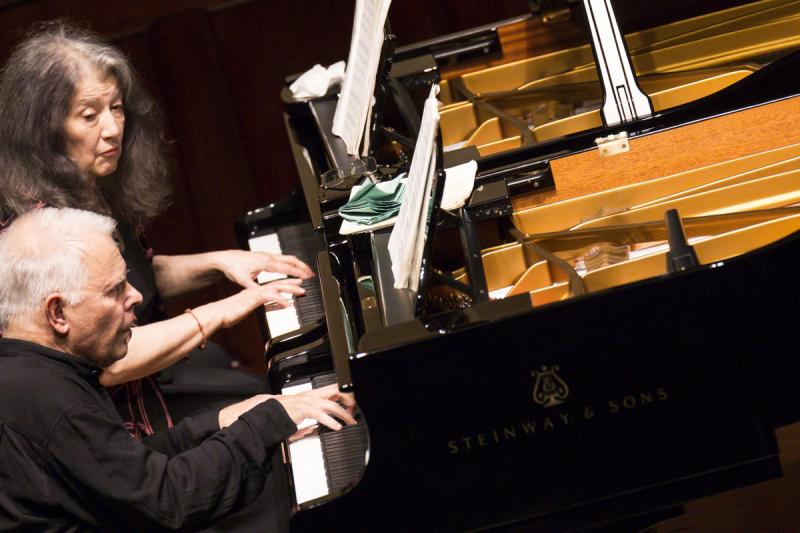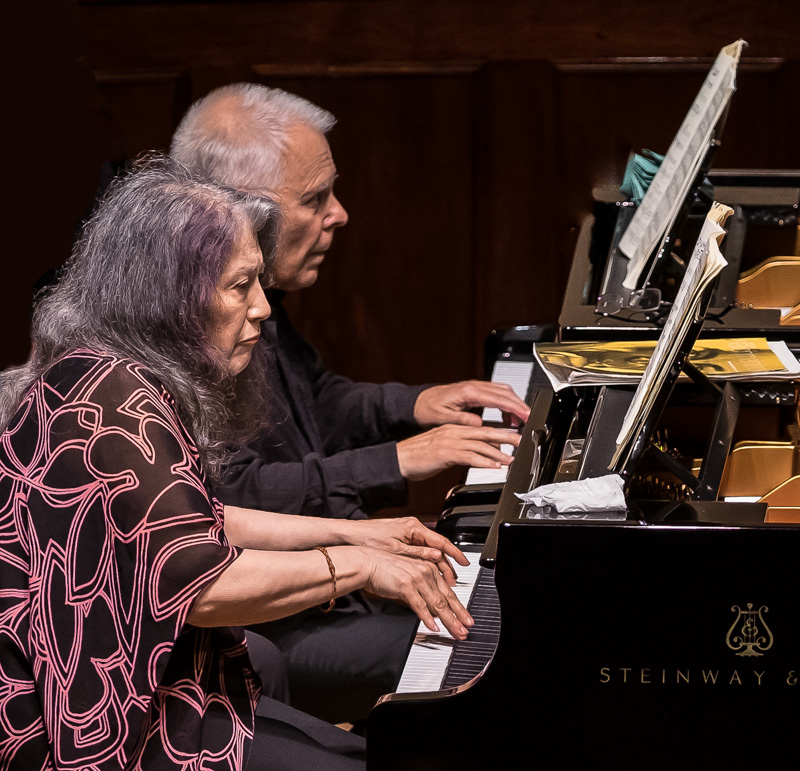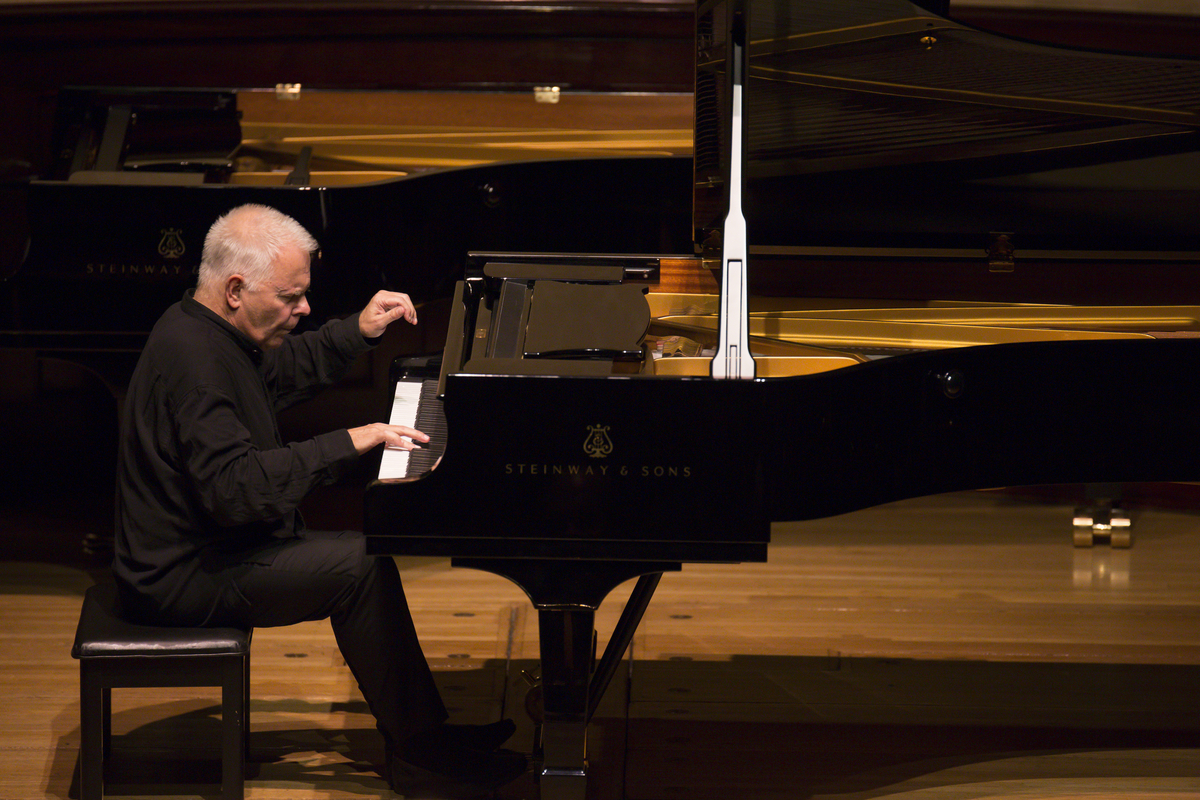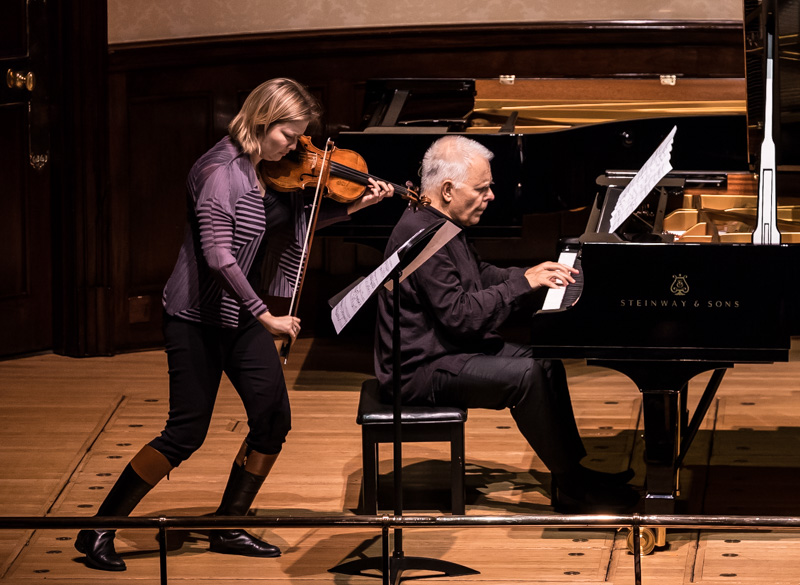Kovacevich, Argerich, Wigmore Hall | reviews, news & interviews
Kovacevich, Argerich, Wigmore Hall
Kovacevich, Argerich, Wigmore Hall
Dangerous, intense at 75 - but does the great American pianist need anchoring?

“People think when a person becomes old, he has to become serene,” declared that great pianist Claudio Arrau in his mid-seventies. “That’s absurd.
Without the promised BBC Radio 3 broadcast, pulled on Sunday, giving a chance to listen again the morning after, I’m not sure. I do know that former partner-in-both-senses Martha Argerich anchored him in Debussy and Rachmaninov without ever losing the necessary sense of danger in the latter.
Argerich took the upper part (pictured below by Clive Barda) in Debussy's En blanc et noir – crystalline, bell-like and never too much in a hall which, as Kovacevich pointed out in interview the other week, can over-amplify things. Aurally, it was perfection; the visuals, from the right side of the hall, meant that you couldn’t see the second pianist or even the second piano. Argerich and Kovacevich sat side by side rather than facing each other, which is the more usual pattern, and everyone remarked on how uniquely low Kovacevich positioned himself at the piano. Part of the fun of a two-piano recital is how you should be able to register visually what at least one of the player’s role is. That wasn’t possible from my seat, but one thing can certainly be claimed: that they played as one, even if when Kovacevich came out on top in the Rachmaninov, his touch turned out to be no longer quite as even as it used to be.

The odd wrong or missing note notwithstanding, the Symphonic Dances turned out to be a formidable late weapon in his armoury (he’s played little Rachmaninov up to now). Between them Kovacevich and Argerich shattered us with apocalyptic chords, took the first dance's curious non allegro marking with unusual but striking heaviness, sang out – literally, in Kovacevich’s case, Glenn Gould-style, and who could begrudge him that? – the nostalgic but still pure melody which in the orchestral version belongs at first to the alto saxophone. The build-up to the return of its main stomp caught fire; the dissolve into the calm coda, transfiguring the First Symphony’s vengeful main theme, had a magical touch from both.
When in interview Kovacevich insisted that the waltz they were going to take more directly belonged to the middle of the third and final movement, I thought he must have got it wrong and meant the rubato-laden second, played swiftly with all the essential freedom. But the most radical re-think was indeed in the keening heart of the last nightmare, painfully in-your-face. Another stunning build, just that little bit more space for the quotation from the “glory” sequence from the Vespers, and then it was all over. At Kovacevich's 70th birthday celebrations, firebrand Khatia Buniatishvili stole the show with a shocking-in-a-good-way Liszt B minor Sonata, but there was no doubt about last night's highlight.

There was still a slight cause for concern over how Kovacevich would handle the Schubert (pictured above by Simon Jay Price). It began serenely but swiftly, seeming to veer out of control within minutes only to be pulled back by the benedictions at the end of an exposition which had to do without the crucial link back to the repeat. After a frighteningly intense development, the same pattern was repeated in the recap, so the veering must have been deliberate. The ultimate aching sadness ultimately transfigured of the great slow movement, though, didn’t have room to breathe, while a blink-or-you-miss-it-scherzo and a finale that soon found its feet seemed deliberately light rather than a continuation of Schubert’s life-and-death struggle.
Well, we must remember that though this is "late period" Schubert, he was still only in his early 30s when he raised questions of mortality like no other composer. Maybe I’m wrong to want Richter’s slow-motion skating on thin ice, or indeed the spaciousness Kovacevich himself found 30 years ago. But this D960 didn’t go deep enough for me.

In interview, Kovacevich had promised encores with two string players from the audience. We got one, Alina Ibragimova (pictured above with Kovacevich by Clive Barda), but the way she played Rachmaninov’s "Vocalise" was a perfect summary of what Kovacevich wants from the composer – no dreamy sentimentality, but a direct and constant song. Then Argerich came back on to the platform and without a “happy birthday” – that, after all, took place over a fortnight ago – the celebrations to a very privileged audience which unhappily couldn’t be joined by a Radio 3 audience were over. It should be noted that proceeds went to SANE and CLIC Sargent, the leading cancer charity for children and young people and their famiies, following in an honourable line which saw Kovacevich produce his Hyperion recording of Schubert’s last sonata for Amnesty International.
rating
Share this article
more Classical music
 Bell, Perahia, ASMF Chamber Ensemble, Wigmore Hall review - joy in teamwork
A great pianist re-emerges in Schumann, but Beamish and Mendelssohn take the palm
Bell, Perahia, ASMF Chamber Ensemble, Wigmore Hall review - joy in teamwork
A great pianist re-emerges in Schumann, but Beamish and Mendelssohn take the palm
 First Persons: composers Colin Alexander and Héloïse Werner on fantasy in guided improvisation
On five new works allowing an element of freedom in the performance
First Persons: composers Colin Alexander and Héloïse Werner on fantasy in guided improvisation
On five new works allowing an element of freedom in the performance
 First Person: Leeds Lieder Festival director and pianist Joseph Middleton on a beloved organisation back from the brink
Arts Council funding restored after the blow of 2023, new paths are being forged
First Person: Leeds Lieder Festival director and pianist Joseph Middleton on a beloved organisation back from the brink
Arts Council funding restored after the blow of 2023, new paths are being forged
 Classical CDs: Nymphs, magots and buckgoats
Epic symphonies, popular music from 17th century London and an engrossing tribute to a great Spanish pianist
Classical CDs: Nymphs, magots and buckgoats
Epic symphonies, popular music from 17th century London and an engrossing tribute to a great Spanish pianist
 Sheku Kanneh-Mason, Philharmonia Chorus, RPO, Petrenko, RFH review - poetic cello, blazing chorus
Atmospheric Elgar and Weinberg, but Rachmaninov's 'The Bells' takes the palm
Sheku Kanneh-Mason, Philharmonia Chorus, RPO, Petrenko, RFH review - poetic cello, blazing chorus
Atmospheric Elgar and Weinberg, but Rachmaninov's 'The Bells' takes the palm
 Daphnis et Chloé, Tenebrae, LSO, Pappano, Barbican review - lighting up Ravel’s ‘choreographic symphony’
All details outstanding in the lavish canvas of a giant masterpiece
Daphnis et Chloé, Tenebrae, LSO, Pappano, Barbican review - lighting up Ravel’s ‘choreographic symphony’
All details outstanding in the lavish canvas of a giant masterpiece
 Goldscheider, Spence, Britten Sinfonia, Milton Court review - heroic evening songs and a jolly horn ramble
Direct, cheerful new concerto by Huw Watkins, but the programme didn’t quite cohere
Goldscheider, Spence, Britten Sinfonia, Milton Court review - heroic evening songs and a jolly horn ramble
Direct, cheerful new concerto by Huw Watkins, but the programme didn’t quite cohere
 Marwood, Power, Watkins, Hallé, Adès, Bridgewater Hall, Manchester review - sonic adventure and luxuriance
Premiere of a mesmeric piece from composer Oliver Leith
Marwood, Power, Watkins, Hallé, Adès, Bridgewater Hall, Manchester review - sonic adventure and luxuriance
Premiere of a mesmeric piece from composer Oliver Leith
 Elmore String Quartet, Kings Place review - impressive playing from an emerging group
A new work holds its own alongside acknowledged masterpieces
Elmore String Quartet, Kings Place review - impressive playing from an emerging group
A new work holds its own alongside acknowledged masterpieces
 Gilliver, LSO, Roth, Barbican review - the future is bright
Vivid engagement in fresh works by young British composers, and an orchestra on form
Gilliver, LSO, Roth, Barbican review - the future is bright
Vivid engagement in fresh works by young British composers, and an orchestra on form
 Josefowicz, LPO, Järvi, RFH review - friendly monsters
Mighty but accessible Bruckner from a peerless interpreter
Josefowicz, LPO, Järvi, RFH review - friendly monsters
Mighty but accessible Bruckner from a peerless interpreter
 Cargill, Kantos Chamber Choir, Manchester Camerata, Menezes, Stoller Hall, Manchester review - imagination and star quality
Choral-orchestral collaboration is set for great things
Cargill, Kantos Chamber Choir, Manchester Camerata, Menezes, Stoller Hall, Manchester review - imagination and star quality
Choral-orchestral collaboration is set for great things

Add comment